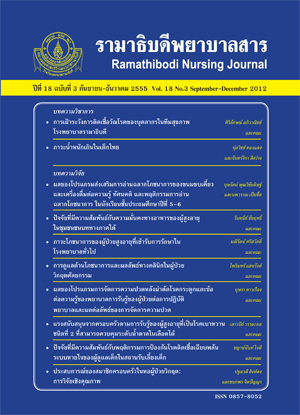ภาวะน้ำลายแห้ง วิธีการจัดการ และผลลัพธ์ของผู้ป่วยมะเร็งศีรษะ และคอภายหลังได้รับรังสีรักษา
Main Article Content
Abstract
บทคัดย่อ
การวิจัยเชิงบรรยายครั้งนี้เพื่อศึกษาภาวะน้ำลายแห้ง วิธีการจัดการ และผลลัพธ์ของ ผู้ป่วยมะเร็งศีรษะและคอภายหลังได้รับรังสีรักษา และความสัมพันธ์ระหว่างตัวแปร โดยใช้ กรอบแนวคิดของดอดด์และคณะ กลุ่มตัวอย่างเป็นผู้ป่วยมะเร็งศีรษะและคอหลังได้รับรังสีรักษา ครบตามแผนการรักษาจำนวน 100 ราย ที่ได้รับการคัดเลือกแบบเฉพาะเจาะจงจากหน่วยตรวจ ผู้ป่วยนอกหู คอ จมูก หน่วยรังสีรักษา และเวชศาสตร์นิวเคลียร์ หอผู้ป่วยจักษุ โสต ศอ นาสิก ของโรงพยาบาลรามาธิบดี มหาวิทยาลัยมหิดล เก็บรวบรวมข้อมูลโดยใช้แบบสอบถามข้อมูลพื้น ฐานส่วนบุคคล แบบสอบถามคุณภาพชีวิตภายหลังได้รับรังสีรักษา แบบสอบถามประสบการณ์การ เกิดภาวะน้ำลายแห้ง แบบสอบถามการจัดการกับภาวะน้ำลายแห้งและผลจากการจัดการ ระหว่าง เดือนมกราคม ถึงเมษายน 2551 วิเคราะห์ข้อมูลโดยใช้สถิติบรรยายและสัมประสิทธิ์สหสัมพันธ์ ของเพียร์สัน ผลการศึกษาพบว่ากลุ่มตัวอย่างส่วนใหญ่เป็นเพศชายมีอายุระหว่าง 18-77 ปี อายุเฉลี่ย 52.56 ปี เป็นมะเร็งช่องคอหลังโพรงจมูกร้อยละ 41 ได้รับการรักษาด้วยรังสีรักษา ร่วมกับเคมีบำบัดร้อยละ 55 ผู้ป่วยมีประสบการณ์การเกิดภาวะน้ำลายแห้งที่มีความรุนแรงแตก ต่างกันตั้งแต่น้อยที่สุดจนถึงมากที่สุด วิธีการจัดการกับภาวะน้ำลายแห้งที่ใช้มากที่สุด 5 อันดับ ได้แก่ 1) รับประทานอาหารที่มีน้ำมากขึ้น ร้อยละ 99, 2) หลีกเลี่ยงอาหารที่มีรสจัด ร้อยละ 98, 3) บ้วนปากบ่อยๆ ด้วยน้ำเปล่า ร้อยละ 96, 4) แปรงฟันหลังรับประทานอาหาร ร้อยละ 95, และ 5) พบทันตแพทย์ ร้อยละ 92 และพบว่าผลของการจัดการกับอาการทำให้ภาวะน้ำลายแห้ง มีอาการดีขึ้น ร้อยละ 57 กลุ่มตัวอย่างมีค่าคะแนนคุณภาพชีวิตโดยรวมตั้งแต่ต่ำสุดถึงสูงสุด โดยมีค่าเฉลี่ยใกล้เคียงกันกับค่ามัธยฐานซึ่งค่อนไปทางคะแนนต่ำ หมายถึงรับรู้ คุณภาพชีวิตที่ ดี ภาวะน้ำลายแห้งมีความสัมพันธ์ทางบวกกับคะแนนคุณภาพชีวิต คือเมื่อมีภาวะน้ำลายแห้งยิ่งมากขึ้น คุณภาพชีวิตยิ่งลดลง และภาวะน้ำลายแห้งมีความสัมพันธ์ทางบวกกับปริมาณรังสีที่ได้รับน้อยลง มีนัยสำคัญทางสถิติ แต่ไม่สัมพันธ์กับระยะเวลาหลังได้รับรังสีรักษาครบ โดยสรุป ภาวะน้ำลายแห้ง จะรุนแรงมากขึ้นเมื่อได้รับปริมาณรังสีมากแต่ไม่ขึ้นกับระยะเวลาหลังได้รับรังสีรักษาครบ
คำสำคัญ : ภาวะน้ำลายแห้ง, มะเร็งบริเวณศีรษะและคอ, การฉายรังสี ประสบการณ์การมีอาการ, วิธีการจัดการ, ผลของการจัดการ
Abstract
The purpose of this descriptive research was to describe experiences of xerostomia, management and outcome, and their relationship in patients with head and neck cancer, post radiation. The symptom management model revised by Dodd and colleagues was applied as the conceptual framework of the study. The participants included 100 patients with head and neck cancer who had received radiation, recruited by purposive sampling from Otolaryngology Department, and Department of Radiology, at a university hospital. Data was collected using a set of questionnaires including the Patient’s Profile Form, the Xerostomia-Related Quality of Life Questionnaire, the Xerostomia Questionnaire, and the Symptom Management Strategies Questionnaire, during January to April 2008. Descriptive statistics and Pearson Product Moment Correlation were used in data analysis. Results showed that the majority of the participants were male (70%), aged from 18 to 77 years with a mean of 52.56 years, had nasopharyngeal cancer (41%), and had received combination treatment with chemotherapy and radiation therapy. Experiences of xerostomia were verious ranging from the lowest to highest score. The top five most favorable methods for management were: 1) foods containing water, sipping water (99%); 2) avoiding spicy and salty food (98%); 3) mouth rinsing and avoiding alcoholic drinks and tobacco (96%); 4) brushing teeth after meals (95%); and 5) following up with dentist (92%). The sources of knowledge in managing the symptom were physicians (84%) and nurses (61%). More than half (57%) reported that their xerostomia had improved. The overall xerostomia-related quality of life ranged from the lowest to highest score by which the mean and the median scores were low, indicating good quality of life. In addition, the analysis revealed that xerostomia was significantly correlated with lower quality of life and higher dose of radiation, whereas xerostomia was non-significantly, negatively correlated with the duration of post radiation. In sum, xerostomia is more severe when the dose of radiation is higher, regardless of how long the radiation treatment has been completed.
Keywords : Xerostomia, Head and neck cancer, Radiation, Symptom experience, Symptom management, Outcomes
Article Details
บทความ ข้อมูล เนื้อหา รูปภาพ ฯลฯ ที่ได้รับการตีพิมพ์ในรามาธิบดีพยาบาลสาร ถือเป็นลิขสิทธิ์ของวารสาร หากบุคคลหรือหน่วยงานใดต้องการนำทั้งหมดหรือส่วนหนึ่งส่วนใดไปเผยแพร่หรือเพื่อกระทำการใด ใด จะต้องได้รับอนุญาตเป็นลายลักษณ์อักษรจากรามาธิบดีพยาบาลสารก่อนเท่านั้น


